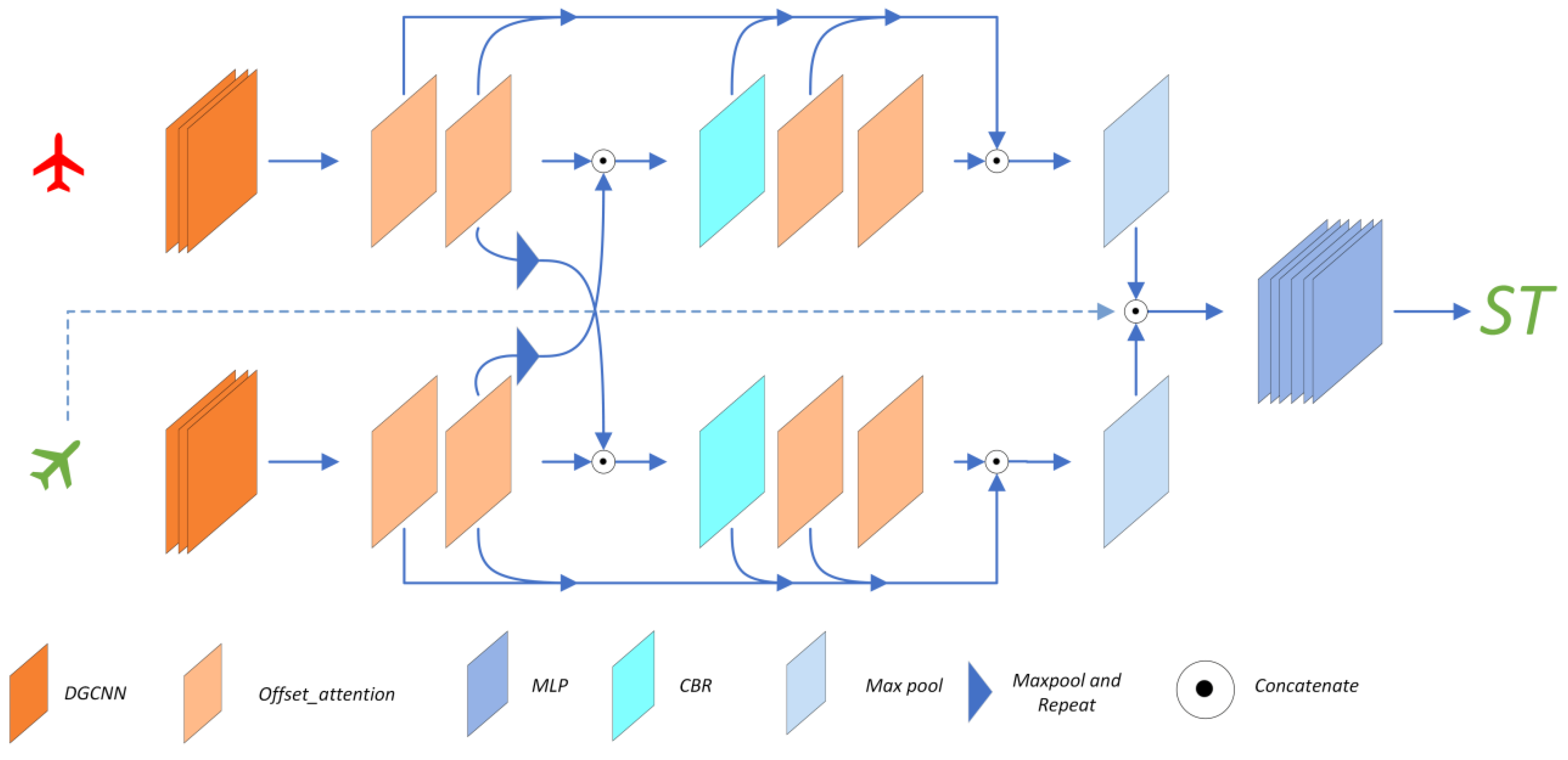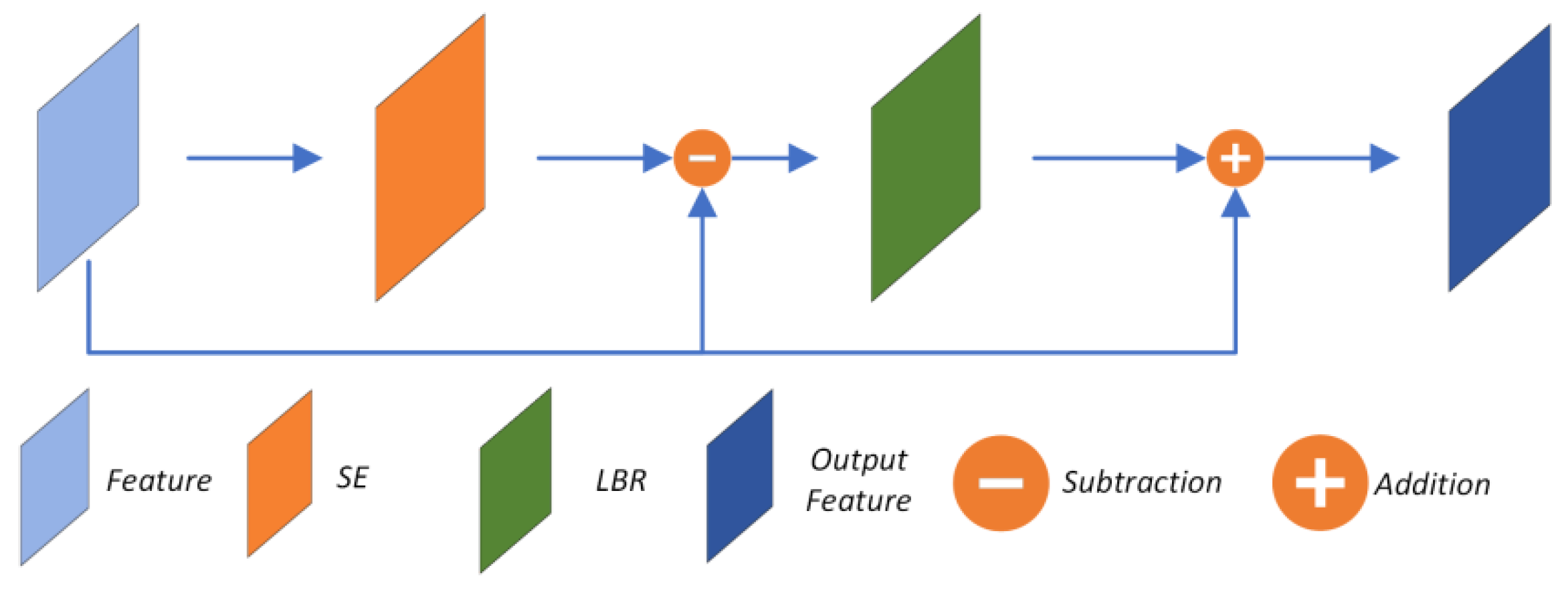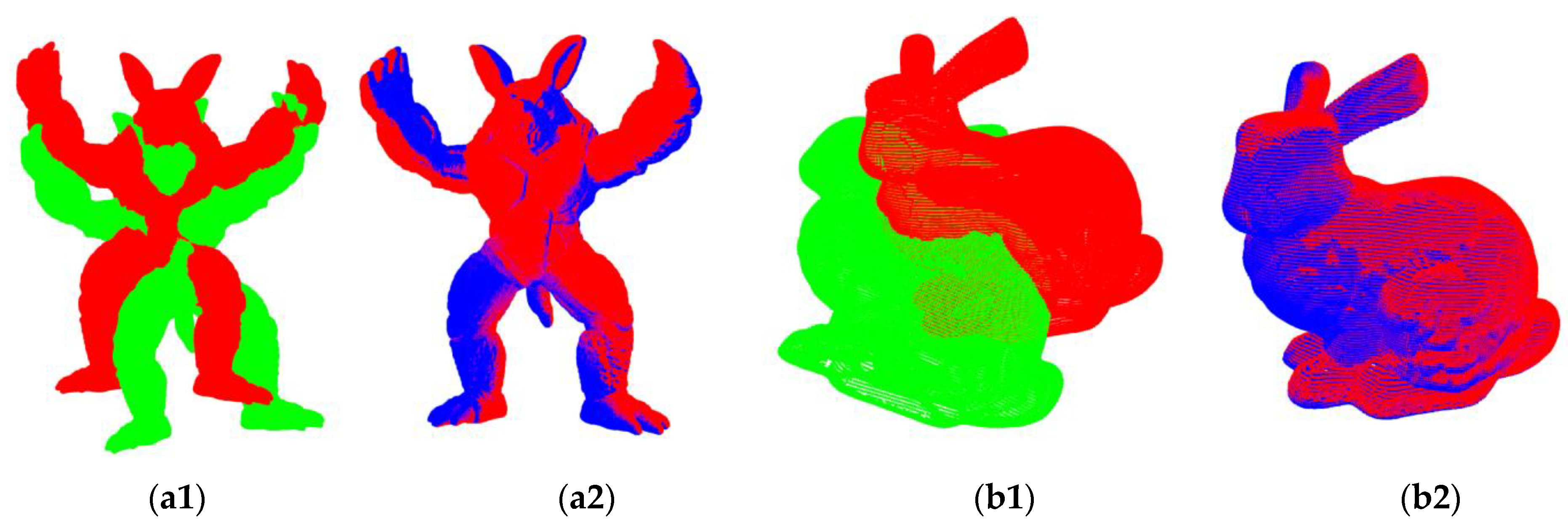DOPNet: Achieving Accurate and Efficient Point Cloud Registration Based on Deep Learning and Multi-Level Features
Abstract
1. Introduction
- We propose an end-to-end registration network that can efficiently extract multiple features of point clouds using DGCNN and an attention mechanism. A feature interaction module is inserted into the feature extraction pipeline to achieve high-quality registration.
- The source and target point clouds were generated by independent sampling, and additional experiments on asymmetric objects from Modelnet40 were conducted, which to some degree achieved a more rational setting for the registration experiments.
- The proposed method was compared with five other registration methods. Adequate experiments verify that DOPNet is capable of extracting more salient hybrid information, as it achieves better registration accuracy and robustness than other methods.
2. Related Work
2.1. Traditional Methods
2.2. Learning-Based Methods
2.3. Attention Mechanism
3. Problem Statement
4. Methodology
4.1. Network Architecture
4.2. Feature Extraction Layer
4.3. Transformation Prediction Layer
4.4. Loss Function
5. Experiments
5.1. Implementation Details
5.2. Comparison and Evaluation Metrics
5.3. Modelnet40
5.3.1. Unseen Shapes
5.3.2. Unseen Categories
5.3.3. Robustness
5.3.4. Calculation Efficiency
5.4. Stanford Point Clouds
5.5. Ablation Studies
6. Conclusions
Author Contributions
Funding
Institutional Review Board Statement
Informed Consent Statement
Data Availability Statement
Conflicts of Interest
References
- Zhao, K.; Ma, L.; Meng, Y.; Liu, L.; Wang, J.; Junior, J.M.; Gonçalves, W.N.; Li, J. 3D Vehicle Detection Using Multi-Level Fusion from Point Clouds and Images. IEEE Trans. Intell. Transp. Syst. 2022, 23, 15146–15154. [Google Scholar] [CrossRef]
- Baek, J.; Park, J.; Cho, S.; Lee, C. 3D Global Localization in the Underground Mine Environment Using Mobile LiDAR Mapping and Point Cloud Registration. Sensors 2022, 22, 2873. [Google Scholar] [CrossRef] [PubMed]
- Mu, Z.; Cai, Z.; Zeng, C.; Li, Z.; Liang, X.; Yang, F.; Chen, T.; Dong, S.; Deng, C.; Niu, S. A point cloud registration-based calibration algorithm for robot offline programming automatic loading in aero-grinding applications. Ind. Robot Int. J. Robot. Res. Appl. 2022, 49, 1218–1228. [Google Scholar] [CrossRef]
- Li, H.; Hartley, R. The 3D-3D registration problem revisited. In Proceedings of the IEEE International Conference on Computer Vision (ICCV), Rio de Janeiro, Brazil, 14–20 October 2007; pp. 1–8. [Google Scholar]
- Besl, P.; McKay, N.D. A method for registration of 3-D shapes. IEEE Trans. Pattern Anal. Mach. Intell. 1992, 14, 239–256. [Google Scholar] [CrossRef]
- Zhang, X.; Li, Z.; Wang, X.; Li, P.; Wang, Y. Research of 3D point cloud data registration algorithms based on feature points and improved ICP. Transducer Microsyst. Technol. 2012, 31, 116–122. [Google Scholar]
- Yang, J.; Li, H.; Campbell, D.; Jia, Y. Go-ICP: A globally optimal solution to 3D ICP point-set registration. IEEE Trans. Pattern Anal. Mach. Intell. 2015, 38, 2241–2254. [Google Scholar] [CrossRef] [PubMed]
- Serafin, J.; Grisetti, G. NICP: Dense normal based point cloud registration. In Proceedings of the IEEE/RSJ International Conference on Intelligent Robots and Systems (IROS), Hamburg, Germany, 28 September–3 October 2015; pp. 742–749. [Google Scholar]
- Segal, A.; Haehnel, D.; Thrun, S. Generalized-icp. In Proceedings of the Robotics: Science and Systems, Seattle, WA, USA, 28 June–1 July 2009; Volume 2, p. 435. [Google Scholar]
- Qi, C.R.; Su, H.; Mo, K.; Guibas, L. PointNet: Deep learning on point sets for 3D classification and segmentation. In Proceedings of the IEEE Conference on Computer Vision and Pattern Recognition (CVPR), Honolulu, HI, USA, 21–26 July 2017; pp. 77–85. [Google Scholar]
- Qi, C.R.; Yi, L.; Su, H.; Guibas, L. PointNet++: Deep hierarchical feature learning on point sets in a metric space. In Proceedings of the Neural Information Processing Systems (NIPS), Long Beach, CA, USA, 4–9 December 2017. [Google Scholar]
- Sarode, V.; Li, X.; Goforth, H.; Aoki, Y.; Srivatsan, R.; Lucey, S.; Choset, H. PCRNet: Point cloud registration network using PointNet encoding. arXiv 2019, arXiv:1908.07906. [Google Scholar]
- Aoki, Y.; Goforth, H.; Srivatsan, R.A.; Lucey, S. PointNetLK: Robust & efficient point cloud registration using PointNet. In Proceedings of the IEEE/CVF Conference on Computer Vision and Pattern Recognition (CVPR), Long Beach, CA, USA, 15–20 June 2019; pp. 7156–7165. [Google Scholar]
- Lucas, B.D.; Kanade, T. An iterative image registration technique with an application to stereo vision. In Proceedings of the International Joint Conference on Artificial Intelligence (IJCAI), Vancouver, BC, Canada, 24–28 August 1981. [Google Scholar]
- Wang, Y.; Sun, Y.; Liu, Z.; Sarma, S.E.; Bronstein, M.M.; Solomon, J.M. Dynamic graph cnn for learning on point clouds. ACM Trans. Graph. 2019, 38, 1–12. [Google Scholar] [CrossRef]
- Wang, Y.; Solomon, J. Deep closest point: Learning representations for point cloud registration. In Proceedings of the IEEE/CVF International Conference on Computer Vision (ICCV), Seoul, Korea, 27 October–2 November 2019; pp. 3522–3531. [Google Scholar]
- Vaswani, A.; Shazeer, N.; Parmar, N.; Uszkoreit, J.; Jones, L.; Gomez, A.N.; Kaiser, Ł.; Polosukhin, I. Attention is all you need. In Proceedings of the 31st International Conference on Neural Information Processing Systems (NIPS), Long Beach, CA, USA, 4–9 December 2017; pp. 6000–6010. [Google Scholar]
- Guo, M.-H.; Cai, J.-X.; Liu, Z.-N.; Mu, T.-J.; Martin, R.R.; Hu, S.-M. PCT: Point cloud transformer. Comput. Vis. Media 2021, 7, 187–199. [Google Scholar] [CrossRef]
- Li, Y.; Bu, R.; Sun, M.; Wu, W.; Di, X.; Chen, B. PointCNN: Convolution on x-transformed points. Adv. Neural Inf. Process. Syst. 2018, 31, 820–830. [Google Scholar]
- Choy, C.; Park, J.; Koltun, V. Fully Convolutional Geometric Features. In Proceedings of the IEEE/CVF International Conference on Computer Vision (ICCV), Seoul, Korea, 27 October–2 November 2019; pp. 8957–8965. [Google Scholar]
- Kurobe, A.; Sekikawa, Y.; Ishikawa, K.; Saito, H. Corsnet: 3d point cloud registration by deep neural network. IEEE Robot. Autom. Lett. 2020, 5, 3960–3966. [Google Scholar] [CrossRef]
- Yuan, W.; Eckart, B.; Kim, K.; Jampani, V.; Fox, D.; Kautz, J. DeepGMR: Learning Latent Gaussian Mixture Models for Registration. In Proceedings of the European Conference on Computer Vision (ECCV), Glasgow, UK, 23–28 August 2020; pp. 733–750. [Google Scholar]
- Eckart, B.; Kim, K.; Kautz, J. HGMR: Hierarchical gaussian mixtures for adaptive 3d registration. In Proceedings of the European Conference on Computer Vision (ECCV), Munich, Germany, 8–14 September 2018; pp. 705–721. [Google Scholar]
- Pais, G.D.; Ramalingam, S.; Govindu, V.M.; Nascimento, J.C.; Chellappa, R.; Miraldo, P. 3DRegNet: A Deep Neural Network for 3D Point Registration. In Proceedings of the IEEE/CVF Conference on Computer Vision and Pattern Recognition (CVPR), Seattle, WA, USA, 14–19 June 2020; pp. 7191–7201. [Google Scholar]
- Lu, W.; Wan, G.; Zhou, Y.; Fu, X.; Yuan, P.; Song, S. Deepvcp: An end-to-end deep neural network for point cloud registration. In Proceedings of the IEEE/CVF International Conference on Computer Vision (ICCV), Seoul, Korea, 27 October–2 November 2019; pp. 12–21. [Google Scholar]
- Huang, X.; Mei, G.; Zhang, J. Feature-metric registration: A fast semi-supervised approach for robust point cloud registration without correspondences. In Proceedings of the IEEE/CVF Conference on Computer Vision and Pattern Recognition (CVPR), Seattle, WA, USA, 14–19 June 2020; pp. 11366–11374. [Google Scholar]
- Niu, Z.; Zhong, G.; Yu, H. A review on the attention mechanism of deep learning. Neurocomputing 2021, 452, 48–62. [Google Scholar] [CrossRef]
- Zhao, H.; Jiang, L.; Jia, J.; Torr, P.H.; Koltun, V. Point transformer. In Proceedings of the IEEE/CVF International Conference on Computer Vision (ICCV), Montreal, QC, Canada, 10–17 October 2021; pp. 16259–16268. [Google Scholar]
- Huang, S.; Gojcic, Z.; Usvyatsov, M.; Wieser, A.; Schindler, K. Predator: Registration of 3d point clouds with low overlap. In Proceedings of the IEEE/CVF Conference on Computer Vision and Pattern Recognition (CVPR), Nashville, TN, USA, 20–25 June 2021; pp. 4267–4276. [Google Scholar]
- Li, Y.; Harada, T. Lepard: Learning partial point cloud matching in rigid and deformable scenes. In Proceedings of the IEEE/CVF Conference on Computer Vision and Pattern Recognition (CVPR), New Orleans, LA, USA, 19–23 June 2022; pp. 5554–5564. [Google Scholar]
- Lang, N.; Francos, J.M. DeepUME: Learning the Universal Manifold Embedding for Robust Point Cloud Registration. arXiv 2021, arXiv:2112.09938. [Google Scholar]
- Wu, Z.; Song, S.; Khosla, A.; Yu, F.; Zhang, L.; Tang, X.; Xiao, J. 3D ShapeNets: A deep representation for volumetric shapes. In Proceedings of the IEEE Conference on Computer Vision and Pattern Recognition (CVPR), Boston, MA, USA, 7–12 June 2015; pp. 1912–1920. [Google Scholar]
- Curless, B.; Levoy, M. A volumetric method for building complex models from range images. In Proceedings of the 23rd Annual Conference on Computer Graphics and Interactive Techniques, New Orleans, LA, USA, 4–9 August 1996; pp. 303–312. [Google Scholar]
- Xu, H.; Liu, S.; Wang, G.; Liu, G.; Zeng, B. OMNet: Learning overlapping mask for partial-to-partial point cloud registration. In Proceedings of the IEEE/CVF International Conference on Computer Vision (ICCV), Montreal, QC, Canada, 10–17 October 2021; pp. 3132–3141. [Google Scholar]
- Kingma, D.P.; Ba, J. Adam: A Method for Stochastic Optimization. In Proceedings of the International Conference for Learning Representations (ICLR), San Diego, CA, USA, 7–9 May 2015; pp. 45–53. [Google Scholar]
- Yan, Z.; Hu, R.; Yan, X.; Chen, L.; Kaick, O.V.; Zhang, H.; Huang, H. RPM-Net: Recurrent prediction of motion and parts from point cloud. ACM Trans. Graph. 2019, 38, 240. [Google Scholar] [CrossRef]





| Total Objects (TO) | Asymmetrical Objects (AO) | |||||||
|---|---|---|---|---|---|---|---|---|
| Error(R) | RMSE(R) | Error(t) | RMSE(t) | Error(R) | RMSE(R) | Error(t) | RMSE(t) | |
| ICP | 9.2680 | 11.6344 | 0.0249 | 0.0283 | 7.5924 | 10.6252 | 0.0213 | 0.0257 |
| DCP | 8.8776 | 6.5896 | 0.0386 | 0.0253 | 8.2090 | 6.5152 | 0.0383 | 0.0252 |
| PointNetLK | 4.1094 | 6.8172 | 0.0325 | 0.0442 | 2.6626 | 6.4858 | 0.0240 | 0.0408 |
| DeepGMR | 6.0436 | 5.2149 | 0.0180 | 0.0119 | 4.6820 | 3.8150 | 0.0180 | 0.0118 |
| CorsNet | 17.6834 | 11.2690 | 0.1194 | 0.0805 | 17.5577 | 11.1810 | 0.1185 | 0.0793 |
| DOPNet | 3.2652 | 3.0954 | 0.0202 | 0.0130 | 2.3790 | 3.0954 | 0.0189 | 0.0130 |
| TO | AO | |||||||
|---|---|---|---|---|---|---|---|---|
| Error(R) | RMSE(R) | Error(t) | RMSE(t) | Error(R) | RMSE(R) | Error(t) | RMSE(t) | |
| ICP | 8.9302 | 10.5838 | 0.0236 | 0.0264 | 7.7656 | 10.3687 | 0.0200 | 0.0236 |
| DCP | 9.7660 | 6.7074 | 0.0397 | 0.0259 | 8.7916 | 6.4918 | 0.0382 | 0.0245 |
| PointNetLK | 4.6391 | 8.1576 | 0.0357 | 0.0523 | 3.0385 | 6.3826 | 0.0265 | 0.0435 |
| DeepGMR | 6.7631 | 5.8911 | 0.0171 | 0.0111 | 5.6436 | 4.9185 | 0.0169 | 0.0109 |
| CorsNet | 18.2673 | 11.5248 | 0.1234 | 0.0825 | 18.3851 | 11.6543 | 0.1259 | 0.0843 |
| DOPNet | 3.4526 | 3.0481 | 0.0148 | 0.0109 | 2.9152 | 2.5419 | 0.0141 | 0.0101 |
| Angle | ICP | DCP | PointNetLK | DeepGMR | CorsNet | DOPNet |
|---|---|---|---|---|---|---|
| 0 | 0.9084 | 7.5824 | 1.7248 | 1.4614 | 33.4483 | 0.0180 |
| 10 | 1.2587 | 5.5909 | 1.9439 | 2.7263 | 26.2406 | 1.9824 |
| 20 | 2.0430 | 5.6339 | 2.2575 | 3.9792 | 20.1014 | 2.1643 |
| 30 | 3.3596 | 6.7853 | 2.7429 | 5.0188 | 16.4299 | 2.8950 |
| 40 | 6.1502 | 8.5904 | 3.7187 | 6.0896 | 16.7891 | 3.0301 |
| 50 | 13.3923 | 11.1812 | 6.3421 | 7.7168 | 20.3785 | 3.8056 |
| 60 | 26.1586 | 15.5790 | 12.7429 | 11.5782 | 26.0397 | 7.2468 |
| 70 | 39.4913 | 23.4601 | 25.1283 | 20.8181 | 33.2745 | 14.8409 |
| 80 | 57.3136 | 35.3365 | 42.6074 | 36.5492 | 41.8893 | 27.1315 |
| 90 | 73.3583 | 49.9891 | 63.1546 | 53.9633 | 51.6397 | 42.0658 |
| Angle | ICP | DCP | PointNetLK | DeepGMR | CorsNet | DOPNet |
|---|---|---|---|---|---|---|
| 0 | 0.0074 | 0.0391 | 0.0178 | 0.0161 | 0.2130 | 0.0124 |
| 10 | 0.0079 | 0.0382 | 0.0193 | 0.0162 | 0.1702 | 0.0152 |
| 20 | 0.0095 | 0.0378 | 0.0213 | 0.0164 | 0.1337 | 0.0140 |
| 30 | 0.0121 | 0.0382 | 0.0246 | 0.0166 | 0.1110 | 0.0139 |
| 40 | 0.0176 | 0.0389 | 0.0308 | 0.0169 | 0.1135 | 0.0143 |
| 50 | 0.0320 | 0.0398 | 0.0448 | 0.0173 | 0.1370 | 0.0156 |
| 60 | 0.0567 | 0.0405 | 0.0794 | 0.0177 | 0.1731 | 0.0222 |
| 70 | 0.0789 | 0.0412 | 0.1447 | 0.0183 | 0.2179 | 0.0379 |
| 80 | 0.1063 | 0.0423 | 0.2280 | 0.0190 | 0.2678 | 0.0617 |
| 90 | 0.1300 | 0.0437 | 0.3237 | 0.0196 | 0.3226 | 0.0881 |
| TO | AO | |||||||
|---|---|---|---|---|---|---|---|---|
| Error(R) | RMSE(R) | Error(t) | RMSE(t) | Error(R) | RMSE(R) | Error(t) | RMSE(t) | |
| ICP | 9.6267 | 11.3117 | 0.0263 | 0.0283 | 8.1309 | 11.0779 | 0.0226 | 0.0253 |
| DCP | 9.0785 | 6.7074 | 0.0382 | 0.0251 | 8.4129 | 6.6357 | 0.0301 | 0.0251 |
| PointNetLK | 4.6918 | 7.3042 | 0.0375 | 0.0471 | 3.0578 | 6.7635 | 0.0279 | 0.0399 |
| DeepGMR | 6.0783 | 5.2392 | 0.0180 | 0.0119 | 4.7300 | 3.8595 | 0.0180 | 0.0118 |
| CorsNet | 17.6645 | 11.2246 | 0.1199 | 0.0807 | 17.7338 | 11.2575 | 0.1196 | 0.0801 |
| DOPNet | 3.3255 | 3.1103 | 0.0202 | 0.0131 | 2.4476 | 1.9277 | 0.0189 | 0.0117 |
| Method | ICP | DCP | PointNetLK | DeepGMR | CorsNet | DOPNet |
|---|---|---|---|---|---|---|
| Time (ms) | 36.2 | 114 | 212 | 15 | 80 | 18 |
| Models | Error(R) | RMSE(R) | Error(t) | RMSE(t) |
|---|---|---|---|---|
| Armadillo | 3.3320 | 1.8380 | 0.0036 | 0.0021 |
| Bunny | 3.3135 | 1.8216 | 0.0031 | 0.0018 |
| DGCNN | OA | FI | TO | AO | ||
|---|---|---|---|---|---|---|
| Error(R) | Error(t) | Error(R) | Error(t) | |||
| √ | √ | 4.2869 | 0.0564 | 3.4803 | 0.0477 | |
| √ | √ | 5.7753 | 0.0765 | 5.1483 | 0.0729 | |
| √ | √ | 4.2748 | 0.0523 | 3.5402 | 0.0480 | |
| √ | √ | √ | 3.2652 | 0.0202 | 2.3790 | 0.0189 |
Publisher’s Note: MDPI stays neutral with regard to jurisdictional claims in published maps and institutional affiliations. |
© 2022 by the authors. Licensee MDPI, Basel, Switzerland. This article is an open access article distributed under the terms and conditions of the Creative Commons Attribution (CC BY) license (https://creativecommons.org/licenses/by/4.0/).
Share and Cite
Yi, R.; Li, J.; Luo, L.; Zhang, Y.; Gao, X.; Guo, J. DOPNet: Achieving Accurate and Efficient Point Cloud Registration Based on Deep Learning and Multi-Level Features. Sensors 2022, 22, 8217. https://doi.org/10.3390/s22218217
Yi R, Li J, Luo L, Zhang Y, Gao X, Guo J. DOPNet: Achieving Accurate and Efficient Point Cloud Registration Based on Deep Learning and Multi-Level Features. Sensors. 2022; 22(21):8217. https://doi.org/10.3390/s22218217
Chicago/Turabian StyleYi, Rongbin, Jinlong Li, Lin Luo, Yu Zhang, Xiaorong Gao, and Jianqiang Guo. 2022. "DOPNet: Achieving Accurate and Efficient Point Cloud Registration Based on Deep Learning and Multi-Level Features" Sensors 22, no. 21: 8217. https://doi.org/10.3390/s22218217
APA StyleYi, R., Li, J., Luo, L., Zhang, Y., Gao, X., & Guo, J. (2022). DOPNet: Achieving Accurate and Efficient Point Cloud Registration Based on Deep Learning and Multi-Level Features. Sensors, 22(21), 8217. https://doi.org/10.3390/s22218217






